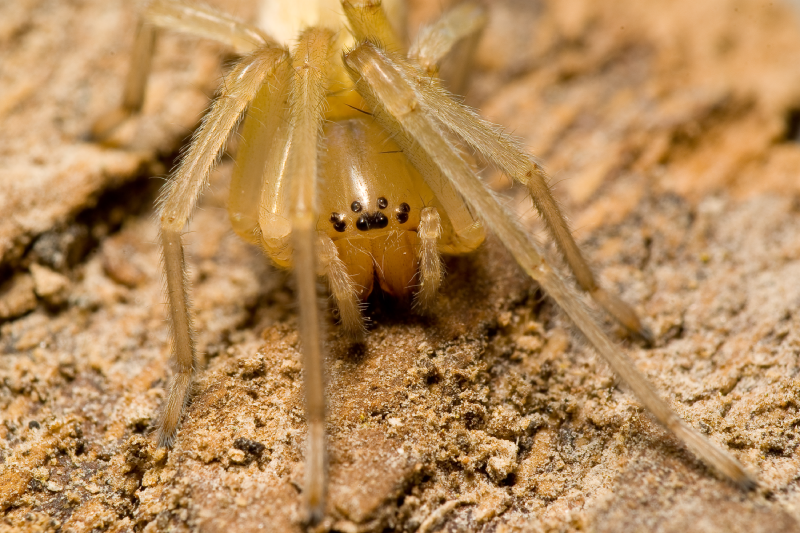
Yellow sac spiders come into homes seeking shelter when the weather turns cool, typically in early autumn and winter. Although these pests are beneficial because they control the number of other insects, their bites can be painful to humans. Learn more about yellow sac spiders, including where they live, what they eat, the dangers they pose, and how to get rid of these pests.
What are yellow sac spiders?
Yellow sac spiders are spiders of the family Cheiracanthium. The species you’ll likely find here in North America is Cheiracanthium inclusum, also called black-footed yellow sac spiders or American yellow sac spiders. These nocturnal arachnids build small silk nests or sacs that they rest in during the day. The spiders like to crawl up and down vertically on walls and other structures. They typically construct translucent sacs in the corners of ceilings and walls.
The yellow sac spider has a pale yellow, light tan or cream-colored body that can contain a hint of green. Measuring just 0.15”-0.31” long, the yellow sac spider is small. It’s often mistaken for a brown recluse spider, but the yellow sac spider doesn’t have the fiddle-like pattern of the brown recluse. The yellow sac spider has a dull, dark stripe lengthwise down its abdomen. Its long fangs are dark brown and sharp enough to cut into human skin.

Where do yellow sac spiders live?
The usual habitat for yellow sac spiders is outdoors, where they live in gardens, bushes, piles of leaves, trees, and woodpiles. When food becomes scarce in colder weather, they seek prey and shelter indoors.
Indoors, yellow sac spiders hide in plain sight, hanging in small silken tubes or “sleep” sacs they create for use during the daytime hours. They rest within these sacs on walls, ceilings, in corners, and behind pictures until nightfall. The spiders like to blend in with their environment, hiding against light-colored, neutral backgrounds.
Yellow sac spiders can rebuild these sacs anywhere, on any given day, giving them a nomadic type of lifestyle.
What do yellow sac spiders eat?
Yellow sac spiders are carnivores that mainly eat other spiders, garden pests, and insects, like cockroaches. Sometimes they’ll ingest their own egg sacs when other food sources aren’t available. These arachnids actively hunt down their prey rather than spinning webs to trap food. They forage for food at night, when they might encounter and bite a human who unknowingly disturbs them.
What do yellow sac spider bites look like?
A yellow sac spider bite resembles two small, raised red bumps spaced about ⅓ of an inch apart. When a yellow sac spider bites, you may feel a sharp, stinging sensation similar to a bee sting. The bite often becomes swollen, painful, and itchy a few hours later.
Some discomfort and other symptoms after being bitten may include headache, nausea, or vomiting. The puncture spots on the skin can become infected if the area isn’t kept clean. An infection or an allergic reaction to the spider bite may require medical assistance.
Are yellow sac spiders poisonous?
These pests are not poisonous, but they are venomous arachnids that tend to bite humans if they feel threatened or are surprised by a person’s sudden movements. They’ve also been known to bite for no apparent reason. Although they inject venom when they bite, yellow sac spiders aren’t deadly.
Do yellow sac spiders jump?
Unlike other types of spiders, yellow sac spiders do not jump. They are excellent vertical climbers, though, and can scurry about quickly.
How to get rid of yellow sac spiders
A pest control company like Hawx Pest Control can help you determine the type of spiders you’re seeing and offer advice on addressing a spider problem.
To prevent these pests from coming inside, you can do the following:
- Inspect the corners of walls at the ceiling and door jambs for web sacs. Vacuum up any that you find.
- Keep outdoor porch lights off at night, as the light attracts the spiders inside
- Seal holes, cracks, or gaps in or around your home’s doors, windows, and foundation
- Remove clutter indoors, especially in dark, rarely used rooms, that can give spiders places to shelter
Pest control services
If you’re aware of yellow sac spiders living in and around your home, it’s best to contact the professionals at Hawx Pest Control to avoid bites and to keep an infestation from getting out of hand. Our experienced, licensed technicians know how to identify and treat indoor and outdoor yellow sac spiders using the most modern technologies, methods, and products available. Call us today for a free estimate.
Categories
RELATED POSTS



